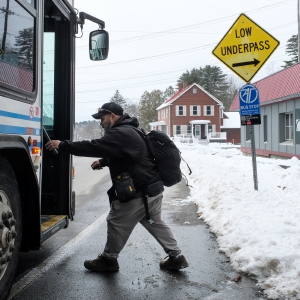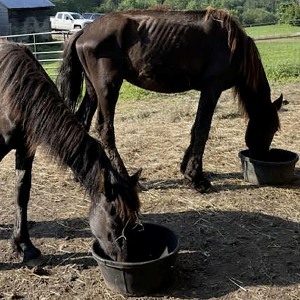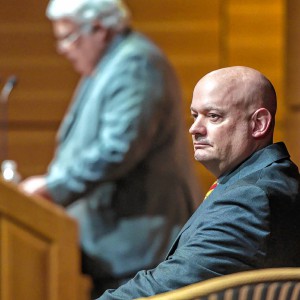The Ghosts of Rennie Farm: Roots of Hanover Site’s Contamination Go Back Decades
| Published: 07-31-2016 12:38 AM |
Hanover
The supernatural whispers had mundane origins: the circles were colonies of fungus, the snakes were drawn to a hot spot in the farmhouse basement, and the corpses — well, that story was true.
Reality, on the other hand, offered scenes eerier than anything the residents’ imaginations could have conjured. In 2011, as the same grim tales surfaced with new work at the site, contractors in full-body hazmat suits were digging up radioactive carcasses, used syringes and soil soaked with a strange purple fluid.
Back in the 1960s and ’70s, Dartmouth College’s medical school conducted experiments on animals using radioactive isotopes, and then buried the remains on an acre of land at the Rennie Farm, a mostly forested 218-acre property off Hanover Center Road. Those excavators in 2011 were working to remove the waste — a job that, the public recently learned, is still not complete.
Now, as Dartmouth announces a dramatic expansion to an effort that it declared closed four years before, neighbors to the site have called for an even more thorough follow-up.
Their demands became public earlier this month in a petition signed by 36 residents from the rural neighborhood, including such high-profile members of the Dartmouth community as Peter Spiegel, former chair of radiology, and Marcelo Gleiser, a widely read author and leading professor of physics and astronomy.
Gleiser, who lives south of the burial ground, said he thinks the school should make every effort to ensure it gets everything this time.
“There are some places where you don’t want to save money, and that’s when human lives are at stake,” he said.
Article continues after...
Yesterday's Most Read Articles
 Upper Valley winter shelters kept dozens warm and dry
Upper Valley winter shelters kept dozens warm and dry
 Former principal of South Royalton School released from prison
Former principal of South Royalton School released from prison
 Owner of Friesian horse facility ordered to pay care costs for seized animals
Owner of Friesian horse facility ordered to pay care costs for seized animals
Dartmouth administrators, however, say their plans are based on hard data that points them toward a more limited scope of work. Searching for extra contamination, they say, is not warranted.
“You need to have a good reason, and not just an intuition,” Ellen Arnold, Dartmouth’s associate general counsel for campus services, said of a request from residents.
The dispute between Dartmouth and its neighbors centers on a disparity in understanding of what constitutes a thorough and responsible cleanup. The two sides interpret circumstances differently — from the moment shovels broke earth, five years ago, to today.
Decades passed after the last burial at the Rennie Farm, in 1977, and life proceeded as normal. Dartmouth rented the old farmhouse to employees for a time, and later demolished it. For years, the quiet, remote site — more than six miles from the Dartmouth Green — stood empty.
In late 2010, college officials floated to regulators at the New Hampshire Radiological Health Section the idea of releasing the Rennie Farm from the license that Dartmouth holds for radioactive substances. Over several months, state and school representatives developed a plan to remove the carcasses from the ground and ship them to professional disposal facilities out West.
Conflicting explanations have arisen for the timing of this effort. Dartmouth officials told the public that the college wanted to protect the environment and make the site safe for the community.
“It’s the right thing to do,” Michael Blayney, who was then the college’s director of environmental health and safety, told the Valley News at the time. “It’s good stewardship and good environmental responsibility.”
But talk also spread that Dartmouth was looking to sell the property, which has been assessed at $1.6 million, and college officials hinted that they would be open to it.
In correspondence with the state, college administrators were more explicit about this possibility.
“Why Now?” asked a slide in a 2011 presentation by Dartmouth that was preserved in state records in Concord. The answer: “Potential buyer for the property.”
Dartmouth acquired Rennie Farm in 1965 as a potential site for a golf course, according to a 1991 internal report, and as recently as January 2015, college administrators still were referring to “prospective buyers of the property,” email records in the state archives indicate.
The dig went forward in November 2011. Dartmouth hired Clym Environmental Services, a waste management company based in Maryland, to excavate the burial ground.
The scope of the work soon ballooned beyond the college’s assumptions. Dartmouth officials, based on contemporary records, had expected to find small animals in 43 plots arranged in a grid.
They found those carcasses — along with other things, according to a 2013 post-excavation report from Clym. Inside the “exclusion zone,” the fenced-off area of the dump site, workers in radiation suits pulled from the ground laboratory glassware, syringes and, in several cases, broken containers of fluid.
“These cans were badly rusted and leaking a purple colored liquid with strong solvent odor,” the Clym report said. “The soil was discolored around the cans and the ground water was also discolored with a purple sheen.”
In late December 2011, to secure the site for the season, Clym backfilled with several feet of dirt that was presumed safe because it had not been adjacent to the waste.
Clym deemed the dig complete in winter 2012, although it noted that in one plot, Number 28, workers had been bogged down by “substantial groundwater intrusion.”
“Efforts were made to remove all loose waste items from the plot, but site conditions made this difficult,” the report said. “Though these items would represent a very small percentage of total waste at the site, it is likely that a number of small waste items remain in the ground.”
The college, loath to disturb human remains, also left behind a small, adjacent plot of medical cadavers. (As many others did, Dartmouth’s medical school used donated corpses for anatomy training, which did not involve radiological experiments, according to college records.)
Post-excavation tests of the burial site, in 2012, found a solvent component called 1,4-dioxane, a substance that the Environmental Protection Agency classifies as a probable human carcinogen. The chemical was present at levels hundreds of times the state standard of 3 parts per billion, but to college officials it appeared to be staying where it was.
The 2011 dig revealed a greater variety of waste than Dartmouth expected, thanks to the incomplete records the college had kept — a circumstance that the neighbors see as a cause for concern.
“They don’t know what they buried,” said Spiegel, the former radiology chairman. “There could be two more, five more, 10 more of those bags.”
When the Valley News asked for a copy of the original radioactive materials permit, for example, college officials said they were unable to locate it.
Nevertheless, state and federal nuclear regulations do not appear to have prohibited the dumping, according to ’70s-era state archives that the Valley News reviewed in Concord. The licenses consisted of lists of radioactive isotopes that the college was allowed to possess, along with references to federal Nuclear Regulatory Commission standards for disposal. The NRC’s code at the time said only that burials could not exceed a certain amount of radioactivity, be too close to the surface or each other, or happen more than 12 times a year.
As for the chemicals found onsite — the 2011 excavators detected odors of naphthalene, a highly poisonous industrial compound, along with 1,4-dioxane and similar substances — they were not regulated until the 1990s, if ever, according to EPA officials in Boston.
In 2013, state officials released the site from its radiological license. Aside from periodic water-quality reports to the state, Dartmouth’s work appeared to be done.
Three years passed. From time to time, Dartmouth conducted tests to confirm that the 1,4-dioxane remained in place.
Then, in the summer of 2015, a monitoring well downhill from the dumping ground registered a spike in dioxane levels. The contamination appeared to be on the move.
Dartmouth conducted tests in several private wells to the northeast, near the path of what it termed an underground “plume” of dioxane.
In the well of Deb and Richard Higgins, who live at 9 Rennie Road, the contaminant was present at twice the state standard. It is unclear how long the 1,4-dioxane has been in their water, since these were the first such tests the college conducted — and, neighbors complained, the first notice they had received of dioxane contamination at the Rennie Farm. But around the same time, the Higginses noticed adverse health effects — sores on their hands, skin peeling away in their mouths — that subsided when they stopped using their well water.
Dartmouth provided the family with bottled water and has offered to dig them a new well. The Higginses, however, object to the siting of that water source and have asked the college to help them relocate, which their lawyer estimates would cost roughly $800,000. The attorney, Norwich’s Geoffrey Vitt, is representing them in talks with the college, which are ongoing.

This animated graphic shows the progression of Dartmouth's post-excavation wells for monitoring 1,4-dioxane over time. Dartmouth started with its first monitoring well, marked in dark red, in November 2011. Testing for the wells marked in red began in April 2012; orange, August 2014; yellow, July 2015; light green Feb. 11, 2016, and dark green a few days later. The Higgins' house is noted with a purple marker. (Source: GZA GeoEnvironmental, Inc.)
Meanwhile, dissatisfaction simmered in the wider neighborhood.
Behind the scenes, residents began to lobby college and state officials. The effort appears to have helped bring about more tests, written records of state officials’ telephone calls show.
In calls to state water and nuclear regulators, neighbors suggested that there could be a link between 1,4-dioxane and the radioactive materials used on animals. Many years ago, 1,4-dioxane was a common ingredient in scintillation fluid, a chemical cocktail that glimmers (or “scintillates”) in the presence of radioactivity, making it a useful tool in the kinds of experiments that scientists conducted on animals back then.
According to documents in the state archive, one of those experiments, from 1975, studied the effect of radiation on small rodents’ reproductive tissue. Scientists in the anatomy department injected radioactive lead into male and female hamsters, and then, once the experiments were concluded, presumably buried them at the Rennie Farm.
In fact, the purple liquid found in the site was scintillation fluid, according to Clym’s report. Soon, state officials were ordering Dartmouth to test for radionuclides along with 1,4-dioxane.
Now, after months of calls to authorities, the neighbors have made their concerns public. Earlier this month, they drew up a list of demands and circulated it in a petition that proclaims their “outrage” at Dartmouth’s “utter disregard” for the environment — and for the residents, themselves.
“My concerns are for the environment as a whole, and for the water supply that is threatened by the drift of these chemical plumes,” Spiegel, who lives on Ferson Road to the south, said in an interview last week.
Spiegel, who recently retired from his position as radiology chairman after more than 40 years at Dartmouth-Hitchcock Medical Center, expressed concern that whatever exuded the 1,4-dioxane could remain onsite. Given enough time, he said, it could spread farther than the Higginses’ well — to a nearby stream, other houses or beyond.
In a later phone call, he also had sharp words for Dartmouth’s decision to limit the scope of the cleanup.
“They promote ethics in business,” Spiegel said, “and here they are setting the example of doing the (most) minimal thing where they’ve polluted the environment. How does that land with their students? If we’re training the future leaders of America at the Tuck School and the college, … to pollute on the one hand is terrible, but then to turn their back and not do a complete job — and fight the community — seems totally inappropriate and disappointing to me, as a Dartmouth alum.”
Last month, a finding at the site appeared to confirm some of the neighbor’s concerns. On June 21, Jim Wieck, an environmental contractor for the college, was surveying the site using ground-penetrating radar, hoping to gain a better understanding of the underlying bedrock. Instead he found three “anomalous areas” — blips on the radar screen.
Two days later, he returned with a backhoe. In two of those spots, he dug up innocuous, nontoxic metals, he said, including what appeared to be equipment that the 2011 excavation team had left in the ground.
In the third, the backhoe bucket caught on a plastic bag containing animal parts. Although the bag had no markings on it, Wieck said — no symbol indicating radioactivity, for example — he and his workers, who lacked protective gear, immediately stopped the dig.
Dartmouth officials arrived later and, after taking it back to a college laboratory, conducted a “swipe test” on the surface of the bag, according to Michael Cimis, the college’s senior associate director of environmental health and safety. The swipe test was negative for radiation, he said, but as of July 21, nearly a month after finding the bagged carcasses, the college had not yet analyzed the tissues.
Neighbors questioned the propriety of testing materials from a controlled site in Dartmouth’s own lab, rather than in an independent facility. But state officials recently sanctioned the action, saying it had been necessary to ensure workers’ safety.
The discovery of the extra waste required Dartmouth to submit a new excavation plan, re-opening a project it ostensibly had finished four years ago.
Given that the location of the waste lined up with the burial plot that gave Clym difficulty in 2011, Wieck and college administrators surmised that a limited amount of material had been missed. In their plan, submitted July 25, they propose to hollow out a 30-foot by 30-foot area around that plot.
“I’m just seeing this as cleaning up a little material that, due to the conditions, was unfortunately left behind,” Wieck said.
Rennie Farm Decommissioning Laboratory Waste Test Pit Excavation Work Plan by Valley News on Scribd
Neighbors, on the other hand, are not confident that this represents all the remaining waste. In their petition, they demand that the full acre of the dumping ground be stripped to bedrock.
The residents have several other provisions in mind. They want a water monitoring system installed around the full perimeter of the Rennie Farm, not in just the area where Dartmouth believes the plume to be traveling; the exhumation of the human remains, which they fear could contain other toxins; a testing program for the known chemicals and radionuclides; timely access to future information; and direct treatment of the underground plume, which until now has advanced virtually unchecked.
That last point is one of the few where the college’s and the neighbors’ plans line up. During a visit to the site earlier this month, Wieck said his company, GZA GeoEnvironmental Inc., was preparing to install a system of pumps to siphon away the 1,4-dioxane underground. That process likely will take more than a year, he said.
Otherwise, Dartmouth officials said, the neighbors’ requests go beyond what their investigation indicates is practical or necessary. Once they implement their plan, they will look out for any remaining contamination, they said.
“If there is a residual source in the soil, we would see that,” Wieck said.
“And we would react,” added Cimis, the college health services official.
A survey of the site before the initial excavation indicated that water naturally flows down the hill toward Rennie Road, and not in any other direction, they said. Removing the human remains would, at the very least, require permission from a judge, they said — and regardless, tests downstream from the cadavers had been clean.
Radiation testing is still ongoing. In a letter sent to more than 200 area residents last month, the college’s director of environmental health and safety, Maureen O’Leary, relayed the news that the state-mandated water tests for radioactive isotopes had come up negative.
“Groundwater samples were recently collected from wells located adjacent to and downslope from the former burial area for analysis of a suite of radionuclides,” she wrote. “Analysis of the samples did not indicate the presence of radionuclides above background levels.”
Earlier, referring to the animals found in June, she wrote, “Testing of that waste ... did not indicate chemical or radiological contamination.”
O’Leary did not mention that the college had not yet tested tissues from those animals, and that some of the monitoring wells that had registered the highest 1,4-dioxane levels had not been tested — in the heat of summer, they were dry.
State officials allowed Dartmouth to test other wells as replacements, and college officials said they were waiting for approval of their work plan before examining the recently discovered carcasses.
And then there is the matter of expense. During the recent visit to the farm, college officials were asked about the anticipated cost of the cleanup.
“We don’t want to know,” said Arnold, the college attorney.
“Expensive,” O’Leary said.
Diana Lawrence, a college spokeswoman, stepped in. The safest answer, she said, was “We don’t know.”
Last week, Lawrence estimated that the project, including the digging and subsequent water remediation, had cost more than $5 million so far.
“Dartmouth is committed to complete the cleanup of the scientific waste burial site on our Rennie Farm property as expeditiously and effectively as possible,” she said in an email. “We share the same objectives as those living near Rennie Farm: We want to protect the health of our neighbors and maintain the value of their properties.”
New Hampshire officials, who have final say over what Dartmouth does on the property, have yet to weigh in on the work plan the college submitted on July 25.
Paul Rydel, the New Hampshire Department of Environmental Services official handling the case, said he was working on responses to both Dartmouth’s and the neighbors’ proposals. His evaluation of the college’s plan should arrive in the coming week, he said.
Neighbors, for their part, say that attempts to rein in costs now will lead only to more surprises — and expenses — later.
“What they are trying to do, in my understanding, is do it in the least costly way,” said Gleiser, the Dartmouth physics professor who signed the petition.
“When you do things halfway, it ends up costing more in the end, because you have to go back and finish the job. So better to go all-out now.”
Rob Wolfe can be reached at rwolfe@vnews.com or at 603-727-3242.
]]>

 Over Easy: ‘A breakfast without a newspaper is a horse without a saddle’
Over Easy: ‘A breakfast without a newspaper is a horse without a saddle’ Lawsuit accuses Norwich University, former president of creating hostile environment, sex-based discrimination
Lawsuit accuses Norwich University, former president of creating hostile environment, sex-based discrimination In divided decision, Senate committee votes to recommend Zoie Saunders as education secretary
In divided decision, Senate committee votes to recommend Zoie Saunders as education secretary
